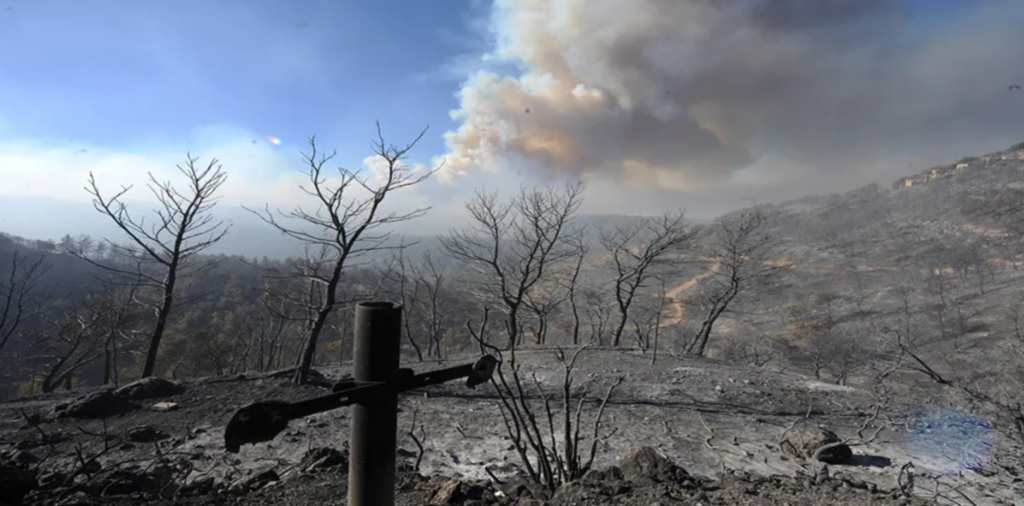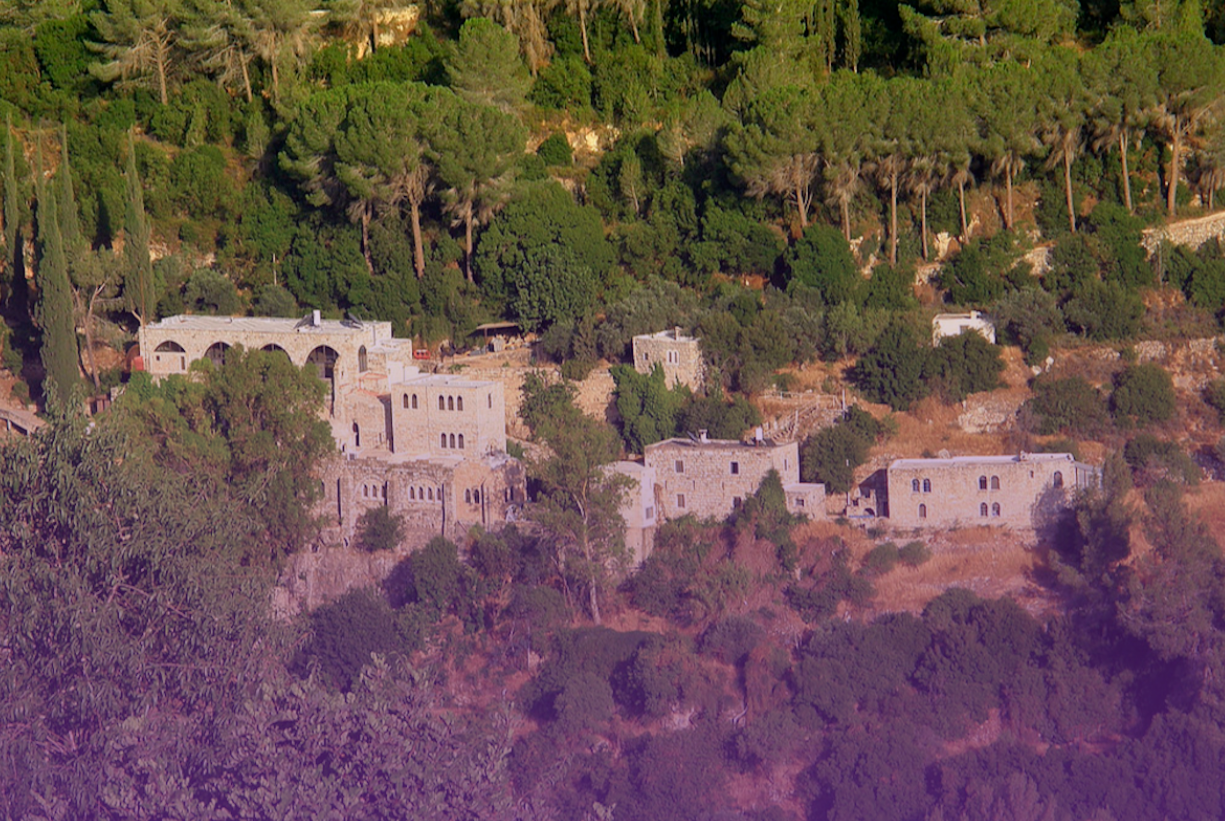Social media are full of pictures of Palestinian landscapes, which are shared to first admire its beauty and then bemoan its loss. When it is about the city of Jerusalem, for example, people often share pictures of the “Jerusalem forest” located in an area of unpopulated villages west of the city. Pines and cypresses fill the scene and dominate the landscape. But what many people don’t know is that these trees spark outrage, and that “Israel” has planted most of them after the 1967 war as part of its war against the Palestinians and its attempt to erase their existence.
Over the past one hundred years, the Zionist movement and later the institutions of the occupation have worked to forest large parts of Palestine, especially the areas occupied after 1948, often claiming that it would “make the wilderness bloom.” However, this claim did not last long, especially in face of the negative impact of tree planting campaigns on the local ecosystem and biome. This warns us about the other purpose of “Israel”: to change the characteristics of the area to steal and erase its identity.
In the Beginning, There Was a Cash Box
As the Jewish immigration to Palestine escalated in the late 19th century, accounts emerged about the European disappointment with the scenery of the Holy Land: a barren country, deprived of trees and forests, contrasting with how they perceived it, as a green land full of springs, as documented in ancient descriptions and Old Testament texts. Following that, there were European and Zionist claims about the “environmental negligence and destruction suffered by Palestine during the Ottoman rule,” the poor management of natural resources, the continuous cutting down of forests, and overgrazing by the Palestinian population.
And so the path was open for the Zionist movement to launch the Palestine tree planting project to “restore it” to its former glory. In 1901, the 5th Zionist Congress was called and one of its consequences was the establishment of the Jewish National Fund (JNF). Its goal was to get donations, buy land in the Ottoman Palestine, and found settlements and agricultural projects to settle and employ Jewish immigrants. The Fund launched a campaign to get donations from Jewish people from all over the world and give each family and school a cash box, known as “the blue box,” to receive donations. The Jewish National Fund also set February 15th as a tree planting holiday to mobilize settlers around the idea.
The Jewish National Fund started afforestation and silviculture campaigns in 1920 in cooperation with the Palestine Jewish Colonization Association (PICA), established by the Zionist baron Rothschild and private associations, under the supervision of the British Mandate. Some of the first forests established were the Ben Shemen and Kiryat Anavim forests, in the district of Ramle. The people responsible for these tree planting campaigns claimed environmental reasons, to prevent landslides, increase soil fertility, improve the level of sediments, and reduce water evaporation rates.
Meanwhile, reports from that time did not conceal how important tree planting was for the Zionists to make the country more acceptable to the “European gaze” and to create Palestinian rural areas that would not differ too much from European rural settings. Forestation projects provided work opportunities for thousands of new Jewish immigrants. This way, the National Fund finished growing trees on 80,000 dunum[1] across Palestine even before the declaration of the creation of the Zionist entity.
After the establishment of the Occupying State, the National Fund completed its afforestation works, this time in cooperation with the Ministry of Agriculture of Israel. They focused on the mountains ranging from Galilee to Jerusalem, and then on north of the Negev desert. Between 1950 and 1960, trees were planted on a 190,000-dunum area and, between 1960 and 1970, on 210,000 dunum. By 2007, trees had been planted on an additional 530,000-dunum area. Today, forests cover approximately 1.18 million dunum of land, of which only around 242,000 dunum are considered native forests, without interference from the Zionist movement, while the rest of it is areas planted by “Israel.” Of these areas, 40 percent are covered in conifers (pines and cypresses), 13.5 percent in eucalyptus, and only 5.1 percent in local trees, like oak trees, carob trees, and olive trees.
These afforestation operations are connected to the goals set by the Occupation State after the Nakba, that is, after erasing Palestinian villages that were displaced. These lands from where residents were displaced were counted off as “absentees’ properties,” which allowed “Israel” to take control of them and then transfer them to the Jewish National Fund, thus becoming the largest land owner in Palestine. Seventy-one displaced villages then became tourist attractions, and more than half of this number was covered in dense forests through tree planting campaigns, as an attempt to change their characteristics and prevent refugees from returning to them.
One of the most prominent examples of this erasure is the Jerusalem Forest, planted in the villages of Al-Qabo, Allar, Soba, Ein Karem, and others. Demolished Palestinian homes can be spotted among pine trees, like in the village of Ajour, in the Jerusalem District, where the Botanical Garden was built, and the village of Lubya, in the district of Tiberias, where the South African Garden was built. Public parks and forests have also been established in villages that became unpopulated after the displacement, such as the villages of Emwas and Yalo in the Ramle district.
This Is How They Burned Carmel
There was a variety of trees planted in the beginning of the tree planting campaigns: during the first Jewish migration, they planted olive trees, for example, in accordance with the agricultural nature of the region. Other varieties were also introduced, such as eucalyptus, or, as the Palestinians call it, “the Jewish tree.” These are trees that grow fast, consume large amounts of water, and are planted around swamps and springs to dry them up. The Zionists have used them to drain Lake Hula in the 1950s. After experimenting with different varieties, the Jewish National Fund decided to grow the Aleppo pine, for its ability to grow fast in semiarid areas and, secondly, because it does not require large amounts of water. This is why the Fund made sure to use it and avoid local varieties, such as oak, carob, and the strawberry tree.
However, the Carmel fires in 2010 sparked a conversation about how inappropriate it is to grow so many Aleppo pines in Palestine, because the low-rainfall area would make it easier for fires to spread. This is because of the chemical composition of pines: the leaves of conifers have a highly-flammable substance called terpenes, and the cones facilitate ignition, which lead to fire blazing through cone opening, making them release seeds and feeding the fire. It is the opposite of oak trees, for example, which are adapted to the nature of the country and are more flame resistant.

In 2019, the Society for the Protection of Nature in Israel published a detailed report attacking the JNF and calling it to stop its afforestation campaigns. The report shows studies that reflect on the national aspects of tree planting on the environment of occupied countries, starting with the characteristics of the Aleppo pine as an invasive species—that is, it can spread and grow to large areas beyond the areas where it is planted. This means that, over the next years, this species can spread to larger uncultivated areas, which, according to the report, endanger other ecosystems—the most important of which is mountainous open forests, which characterize nature in Palestine.
Biodiversity is also endangered. Large areas of land covered by the shadow of pine trees prevent wild plants from growing beneath them, due to the lack of sunlight and water. Moreover, the leaves that fall to the ground from the pine trees stop other plants from growing, because they are too acidic. As for the animals, there are species of reptiles and birds of prey—whose predatory ability is related to open spaces—that are endangered because they are not adapted to this exotic system.
The Reasons Behind the Disappearance of the Lizard
Maybe one of the most controversial examples is the Yatir Forest, which started to be planted in 1964 on the southern slopes of the Hebron hills and north of the Negev desert. It is the largest forest ever planted by the Jewish National Fund in the country, in the Bedouin lands of Khirbet Atir, covering a 30,000-dunum area with more than 4 million trees, mainly pines and cypresses. To expand the forest, the Palestinians were forced out of their villages and displaced to the town of Hura.
The JNF claims that the Yatir Forest aims to fight desertification and climate change, boasting about it as a role model of prosperity in the desert and as a study model for forest planting and care. This, however, is the opposite of what is happening.
The forest endangers a desert ecosystem that is rich in plant and animal species that live in that particular area, such as the Faqqua iris or the Jordan’s black iris, a type of wild garlic, and a lizard species called Be’er Sheva fringe-fingered lizard, now officially declared critically endangered. It is an endemic species; that is, it only lives in this area, and it is subject to changes in its natural habitat because of this cultivated forest, which results in areas that are not appropriate to it, as it needs sunlight.
In 2010, the forest was exposed to an environmental disaster, as 24,000 trees caught fire in one year, especially large trees over 35 years old. This happened because the area was exposed to a severe drought in 2008, as a result of the shortage of natural nutrients and soil composition.
The Wall: An Example of the Hypocrisy of “Israel”
“Israel” and, backstage, the Jewish National Fund boast themselves of the ecological model that they have created nearly one hundred years ago in the land of Palestine. They say, “while the percentage of forests in the world is decreasing, in Israel it is the opposite.” With “Israel,” the opposite is really happening. Thousands of olive trees are cut off in the West Bank and, in the past two years alone, more than 15,000 of them have been destroyed. The land is demolished to build settlements in the West Bank and Jerusalem, thus endangering the local natural habitat and biodiversity. The wall is built isolating living organisms on one side of it, making them unable to move naturally, reducing their numbers and areas, and causing ecological imbalance.
“Israel” is an eco-hypocrite, with its double environmental standards for each side of the wall. Israel thus proves it is lying. The environmental values it promotes and the forests it creates are only an aspect of the land control and the changes it imposes on the particular features of the area to prevent it from continuing to be Palestinian.
____
[1] Dunum is a unit of area that is not included in the International System of Units. A dunum originally represented the amount of land that could be ploughed in a day, therefore varying from place to place. The concept is still used, following a more uniform standard, in several countries that used to be part of the Ottoman Empire.
Dua’a Subhi was born in Jerusalem and is currently pursuing a master’s degree in forest science and natural resource management at the University of Padova, Italy, with an interest in the nature of Palestine. This article was originally published in Arabic on July 23rd, 2021 on the Metras portal, a platform focused on producing knowledge and journalistic content about Palestine.




